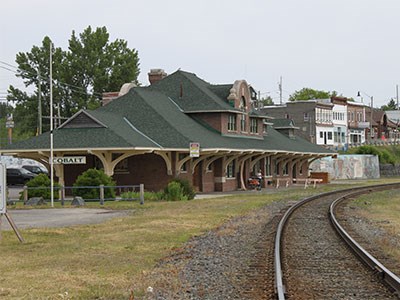After purchasing the Cobalt train station earlier this spring, Winnie Kammermayer and her team set to work renovating the 105-year-old building. A lick of paint here, a minor repair job there, and Kammermayer figured she would be ready to open her new upcycling business.
But scraping off a chunk of thick, layered paint revealed the heritage building’s original oak ceilings, and suddenly the project took on an entirely new significance.
“We were just going to repaint the ceiling, repaint all the trim; we were going to patch up the floor the way it was,” she said. “Once we started sanding and clearing that ceiling, it was like, wow — that’s gorgeous.”
Appraising the ongoing work in early July, visitors can see Kammermayer’s careful work is paying off. All the original wood — ceilings, doors, window trim — has been sanded down and restained to reveal its chestnut-hued grain. Any repairs have been made with original lumber found on site.
The glazed brick of the general waiting room has been repainted in cream, soft green, and black, selected from a palette originating from 1910 that Kammermayer discovered during her research into the era.
The floors, parts of which were covered with layers of tile and carpeting through its many incarnations, will be restored to their original state. Comprised of concrete and topped with a half-inch layer of concrete and crushed quartzite, the floors give off a sheen similar to that of polished marble. Kammermayer will import a special machine from Toronto to restore them.
She even has some original artifacts to add to its authenticity: two original benches and a baggage cart, as well as black and white photographs that depict the station in its heyday.
To date, the cost of the work has run into the tens of thousands of dollars, and there’s more to come, but Kammermayer contends it’s warranted to restore such an important building to a state that’s as close to original as possible.
“It’s come a long way,” she said. “It’s definitely a project of love, from the heart, because there’s lots of physical work and lots of financial work.”
Built in 1910 for the Timiskaming and Northern Ontario Railway, the station was the centre of activity during the town’s silver boom, which started in 1903 and is considered to be the birth of hard-rock mining in Canada. Prominent figures were shuttled in and out of Cobalt via the rail station, as were the tonnes of silver that were extracted from its mines.
“This train station is actually special because it was designed by the same designer that designed the Toronto train station,” Kammermayer said. “Cobalt had to be pretty important back in the day.”
For Kammermayer, acquiring the station was a dream come true. She grew up in Cobalt — the building was a popular hangout spot in her youth — and she had loved the structure from afar, even while spending more than three decades living and working in Alberta.
When she returned to her hometown, she began renovations at one of her properties — she owns several throughout the town — until a neighbour informed her of the station’s availability.
“I had no clue it was even for sale,” Kammermayer said. “What a fluke.”
The decision to list the town’s central treasure wasn’t a popular choice with a lot of townspeople, but Mayor Tina Sartoretto maintains it was the right decision. She’s eager to see the transformation and enthusiastic about the contribution Kammermayer’s making to the community.
“We’re quite excited about that, because they’re investing a lot of time, money and energy,” Sartoretto said.
The train station had actually been on the market for a year before Kammermayer acquired it.
“I give the town credit, because they could have sold it to somebody for a storage building and they would not sell it,” Kammermayer said.
Along with her upcycling business, Hometown Décor Emporium, she plans to transform the former telegraph office into a coffee shop with a small kitchen, and the former ladies’ waiting room to a sitting area.
The baggage room is currently being used as storage for the interpretive displays that once welcomed visitors. Kammermayer has agreed to store them for now, but eventually that room may become her workshop.
Next year, she plans to extend the coffee shop seating outside, and will invite vendors to an outdoor community market. Engineering company AECOM, which has maintained offices in the upper level of the station for the last 25 years, will remain in the building.
“My intention is to keep the history of it, so anything I’m doing is for the betterment of it,” Kammermayer said. “I’m not looking to make it into a modern building.”




